“What Paris has, it has an ethos, a life; it has a spirit all of its own. Like a wine, it has a bouquet. You have to choose one of the vintage years, of course.” -Tom Baker as Doctor Who

There are quite a few things I simply adore about traveling in Europe, and one of the things I adore is how easy it is to travel by train. In 2006, I was in Europe for three and a half weeks, and my friend Kari and I traveled only by train–no cars–from England to France to Germany to Denmark to Sweden to the Czech Republic to the Netherlands. And it was absolutely wonderful. What’s also wonderful is the fact that London and Paris are connected to each other by the Eurostar train, and if you book far enough in advance (as we did), you can get round trip tickets for $96. (However, if you wait until the very last minute to book, you’d be paying $258 just for one way.) So, it’s really quite remarkable that with a little bit of planning, you can have a lovely day trip to Paris from London for really very cheap.
We elected to maximize our time in the City of Light (I actually never really liked that moniker) as much as we could, so we got tickets for the 5:40am train from St. Pancras International to Gare du Nord in order to arrive in Paris by 9:22am. Be warned: this means you have to arrive at the station by about 4:40am in order to go through all of the security. Our excitement was so high, however, that it was difficult to actually notice any feelings of tiredness. (I also still did manage to get six hours of sleep on top of it all, so it all worked out really well, all things considered.) And once the train is off, you can expect to be in Paris in under three hours. Simply remarkable!
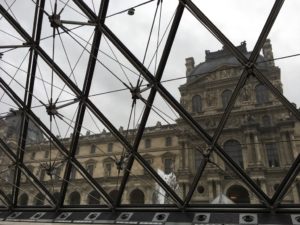
Since we wanted to see the Louvre and the Eiffel Tower and enjoy a lovely meal and walk around Paris’s boulevards in a single day, we had to plan things down to the hour. We arrived at Gare du Nord right on time at 9:22am and needed to navigate to the Louvre right away in order to arrive on time to make use of our 10:30am tickets to the museum. (Even with advance tickets, there was still a line to get through the Louvre’s security, but do buy your tickets to the Louvre ahead of time to save time standing in another line just to get a ticket.) Getting to the museum was really quite fun, as we got to ride on Paris’s Metropolitain (Paris’s version of the London Underground, of course), gazing upon those iconic art nouveau entrances (designed by Hector Guimard in the early 20th century) with their double lamp posts holding that classic Metropolitain sign, like two flower stems gracefully caressing a shard of pale springtime sun. We took the oh-so-creatively named 7 train (why Parisians didn’t take a note from the London Underground and name their Metro lines something more whimsical) from the Poissonnière station to the Palais Royal Musée du Louvre station, electing to buy a day pass for unlimited rides on the Metro for only 6 euros a piece (having inadvertently purchased day passes for children rather than adults, which would have been 12 euros a piece… please don’t tell anyone).
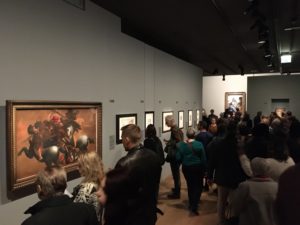
When we planned our visit to the Louvre back in the summer, we were so excited to learn that the museum was presenting a special exhibit featuring the work of Leonardo da Vinci (marking the fifth centenary of the artist’s death). So, naturally we purchased tickets for the exhibit, which also gave us access to the permanent collection. (You’re out of luck if you would like to go to the da Vinci exhibit, as there are no tickets available for the rest of its run, last I looked.) When we arrived (and I should have been expecting this) the exhibit was jam packed full of patrons, which made the whole experience appreciating Leonardo’s work all the more difficult, as there were no opportunities to have private moments with, for example, the Vitruvian Man. Rather, people crowded around the drawing, looking at it not through their own eyes but through their phones as they tried to take a photo of the damn thing. (Admittedly, I was doing the exact same thing, which made me realize how much we spend our days looking down a phone. It’s kind of horrible.)
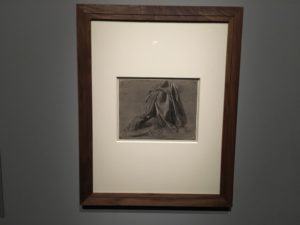
Too many people in one space aside, it was really quite lovely to see so much of Leonardo’s work in one place. The whole exhibit was organized into four sections, and the first section highlighted Leonardo’s skill at painting light and shade. On display was a series of paintings of figures draped in fabric. Such an image may seem like nothing today, but in Leonardo’s time, no one really had yet been able to bring such drama to some elegantly draped fabric in such a realistic and enchanting way. (Plus these paintings are over 500 years old!) The second section was titled “Freedom,” which highlighted what Leonardo called componimento inculto or intuitive composition. There are a couple of examples you can look at that help demonstrate this kind of composition (his Madonna with a Fruit Bowl and his Madonna of the Cat), and you can see a frenetic energy behind the pen strokes that captures deliberate and graceful movements within the drawing. It was in this section of the exhibit where I also got to view La belle ferronnière, which is possibly a portrait of Beatrice d’Este or Lucrezia Crivelli or Isabella of Aragon. I prefer to think that it’s Beatrice (wife to the Duke of Milan), as I had recently performed an arrangement (violin, viola, piano) of a dance from a ballet by composer Reynaldo Hahn, Le bal de Beatrice d’Este–a work of music about what a ball might have been like at the Duke and Duchess’s palace (and who were both quite the patrons of the arts, having funded Leonardo’s work on The Last Supper). The image of Beatrice d’Este is so striking because, as the guidebook to the exhibit explained, “This work revolutionised [sic] the female portrait genre, introducing dynamic movement, more accurately rendered articulations, and an elusive gaze.” Certainly, Leonardo’s interest in intuitive composition, which helped him understand movement, deeply informed this (and other) paintings.
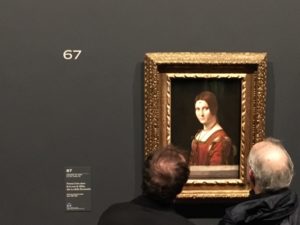
The third section (“Science”) highlighted Leonardo’s insatiable appetite to understand and question, so on display were various drawings of water gushing from a duct, human bones, and–of course–The Virtruvian Man. The whole exhibit closed with a fourth and final section called “Life,” which highlighted how his componimento inculto gave way to sfumato, that painting technique exemplified by lineless images where objects and spaces slowly blend into one another creating softened and misty forms. I got to view some real classics in this section, including Head of a Woman, The Virgin and Child with Saint Anne, and Saint John the Baptist.
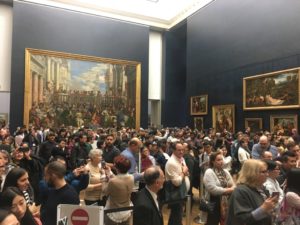
If it feels like I’ve rushed through these last two sections of the exhibit, it’s because we rather had to keep on moving if we were to fit everything in that we had planned for the day. (Plus, my attention span in museums–no matter how dull or how great the place is–is about 43 minutes long, 62 minutes if something is really engaging.) Since we had access to the permanent collection with our da Vinci tickets, we did that oh-so-touristy thing of quickly finding the Mona Lisa (rushing past Liberty Leading the People totally on accident) and quickly finding the Venus de Milo, and then quickly rushing out of the Louvre altogether (where some young boys wanted to scalp our tickets). I must admit that the next time I’m in Paris I will probably not be going to the Louvre. I had been to this place once before, and I enjoyed my time immensely. But, this time around the museum was much more busy than I remembered it: droves and droves of people staring at incredible art through their phones as they take 17 pictures of whatever it is they’re not actually looking at; lines and lines of people queuing up to take a selfie with the Mona Lisa; hoards and hoards of people obscuring the view of something you yourself are trying to view. It was actually a somewhat unpleasant experience. (That said, I’m still glad I went, I suppose. Humans have got to put their phones down, though.)
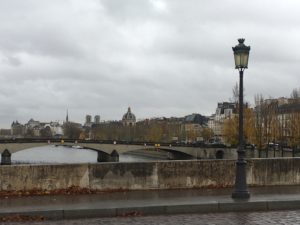
Following the Louvre, we made our way to a restaurant called La Calèche (“The Carriage,” but it sounds so dumb in English) via the Pont Royal (one of the many bridges spanning the Seine from which we were allowed a momentary glimpse of a distant Notre Dame). The meal at La Calèche was improbably exquisite. Really. Some of the best food I have ever had. (It really is true what they say about the French and their food: c’est magnifique!) We started with sharing foie gras and chutney served with bread. Before you judge me for eating foie gras (not that anything I say can really excuse me), please know this was the first time I’ve ever had the sinful dish (and I’ll probably only have it maybe 3 more times in my entire life… well, maybe 23 more times). I’ve long been curious about foie gras, and I’m so happy that the first time I had it was in Paris (despite the grief I felt of indulging in such an unethical food). It was so creamy and so flavorful and just so, so good. For my main dish I had onglet de bœuf mariné, purée de patate douce et chimichurri, which was the tenderest slice of beef I have ever had, each piece just melting in my mouth and floating away in a celebration of euphoric ecstasy, delicate aromas, and transcendent flavors. And the sweet potato puree (everything sounds so dumb in English) was a cloud of sweet, buttery, self-indulgent bliss. For dessert I had my very own gâteau au chocolat with crème fraiche, and it was just so indescribably good. Seriously, I don’t know how to describe it. Each bite was an elegant triumph dancing about my mouth, a ballet of chocolate, a festival of sinful lust.
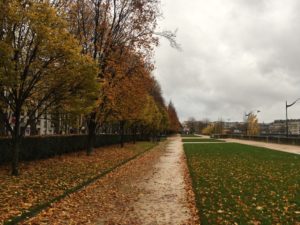
So, you simply must go to La Calèche, so conveniently located near the Louvre. Not only was the food just so, so good, the service was equally lovely and so, so friendly. I had quite the crush on our waiter, too, who was so warm and friendly as he helped translate the menu for us. And he was just so, so happy when I said what very little French I knew: “Oui! C’est magnifique! Merci beaucoup! Je voudrais boeuf! Je voudrais thé au lait! Au revoir!” I’m sure later on he spoke to his friends about how horribly I pronounced everything, but in the moment he seemed genuinely pleased I was able to say anything at all. Perhaps it was because I never once inquired, “Parlez vous anglais?”
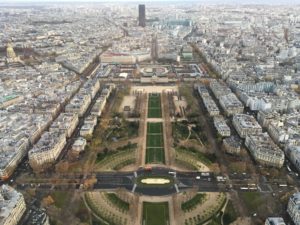
Following dinner, we enjoyed a walk towards the Eiffel Tower along the Seine, catching glimpses of the Assemblée Nationale (home to the lower house of the French Parliament, a Greco Roman style building complete with twelve Corinthian columns); Les Invalides (a complex of museums and churches that also is home to Napoleon’s tomb, the golden Dôme des Invalides rising elegantly above the 17th century classical facade of the Musée de l’Armée); and the Grand Palais (home of the Universal Exhibition of 1900, a graceful structure of steel, stone, and glass, like a giant greenhouse, built in the Beaux-Arts style). Arriving right on schedule for our 4:30pm tickets to ascend the Eiffel Tower (do make sure to buy your tickets ahead of time, as we did), we made our way all the way to the top for some lovely, lovely views of the city. Last time I was in Paris, I didn’t prioritize ascending the tower, and I’m so glad that I finally did this time around. Viewing Paris from above is really quite a sight, as the city seems to have been planned with an ornate symmetry: wide boulevards segmenting grand buildings in a perfect geometry of triangles and trapezoids; the still-green-in-November Champ du Mars reaching towards the horizon; bridges crisscrossing the Seine in a masterful choreography. Even though I’m terribly afraid of heights (the lifts shake and the wind buffets the tower), it was really very exhilarating going all the way to the very top, and I highly recommend you carve time out of your visit to do the same. I also highly recommend that you time your visit to coincide with the setting sun, so that you can see this gorgeous city slowly light up in a soft, luminous glow as the sun disappears. It also allows you views within the tower as it, too, lights up.
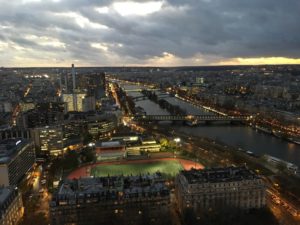
By this point, we had to start making our way back to Gare du Nord to catch our 9:13pm train back to London (keeping in mind that we had to be back to the station by 8:13pm on account of security), but we were still able to move at a leisurely pace. We made our way to the Bir-Hakeim station (the walk allowed us views of the Eiffel Tower all aglow in light, even catching the top of the hour when it shimmered and sparkled for five minutes like a Christmas tree), so we could catch a 6 train to the Arc de Triomphe, that famous monument to those who fought and died for France in the French Revolutionary and Napoleonic Wars. Obviously, the Arc de Triomphe is a marvelous, well, triumph in 19th century neoclassical architecture, and I always forget that it’s so big, standing at 50 meters tall. (Next time we shall have to carve out enough time to actually ascend all of its 280 stairs to allow ourselves even more breathtaking views of the city.) What’s perhaps not so much of a triumph, however, is the ridiculous Place Charles de Gaulle, that insane roundabout that totally surrounds the Arc. Historically called Place de l’Étoile because twelve avenues radiate away from the roundabout like a giant star, the roundabout must have had at least ten lanes of discordant traffic, angry drivers honking horns, brave souls weaving in an out of lanes that were constantly shifting and changing. At one point, Marie joked, “The Arc de Triomphe is lovely, but my god, would you look at this roundabout?”
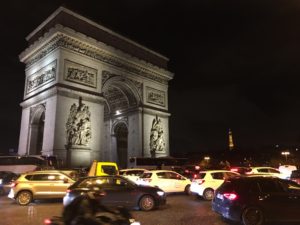
We still had a spare few minutes, so we took a stroll down the famous Avenue des Champs-Élysées, one of those twelve avenues that converge on the Place Charles de Gaulle. Amy remarked that every city has a “Times Square” (in other words, a place so famous that so many people flock to the place just to flock to the place that it becomes overrun with people just flocking to a place because of the place’s reputation as a place to flock to); London has Picadilly Circus, for example, and Paris has Champs-Élysées. It was fine seeing this wide, busy street, its trees all lit up in tiny, gorgeous, red lights, the Arc de Triomphe standing majestically at one end, traffic slowly and inexplicably making its way towards the most ridiculous roundabout ever, but it’s not an avenue I’d probably deliberately seek out again. We did, however, enjoy some lovely hot chocolates at a little place called Jeff de Bruges, a French chain known for its chocolates and confections, and I also bought some Kusmi brand tea (from a drug store, of all places).
And just like that, our time in Paris came to a close. To get back to Gare du Nord, we got to ride on two of Paris’s RER trains (that’s Réseau Express Régionale or Regional Express Network), the A train and then the B train. These trains are slightly comfier than the regular trains on account of the greater distances they travel, but the train passes we bought were used interchangeably between the two systems.
Our adventures continue for two more days back in London. When I next write, I’ll regale you of stories of how pleasantly surprised we were how much we enjoyed visiting the Churchill War Rooms and then how unpleasantly surprised we were to learn that Evensong at Westminster isn’t all that it’s cracked up to be.

I saw the Louvre when I was in the Navy before the Pyramid was built and again in 1969 on my honeymoon with your mom when the Pyramid was put up. To me the Pyramid looks out of place standing in front of the Louvre.